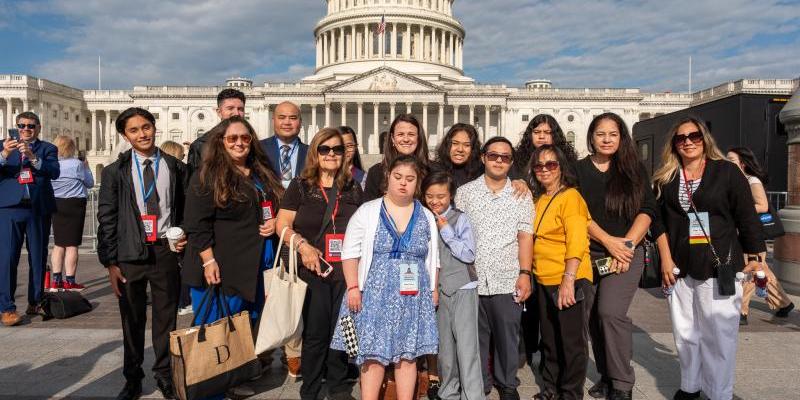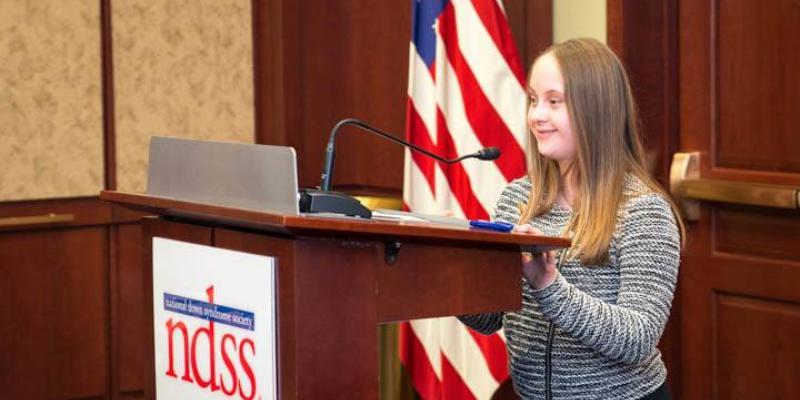EXTERNAL EAR CANAL STENOSIS
Stenotic ear canals (narrow ear canals) can occur in up to 40-50% of infants with Down syndrome. Narrow ear canals can make the diagnosis of middle ear disease difficult. Cleaning of the ear canals by an ENT specialist is often necessary to ensure proper examination and diagnosis. Ear canals grow with age, and may no longer be of concern after age three. If a child with Down syndrome has stenotic ear canals, he or she should see an ENT specialist every three months to avoid undiagnosed and untreated ear infections.
CHRONIC EAR INFECTIONS
Children with Down syndrome have an increased incidence of upper repertory tract infections, which predisposes chronic ear infections. The facial anatomy of Down syndrome also predisposes chronic ear disease.
The middle ear is aerated by the eustachian tube, a small tube that goes from the middle ear space to the area behind the nose in the nasopharynx. Upper airway infections or allergies can cause the eustachian tube to become swollen, trapping bacteria and causing ear infections. Low muscle tone (hypotonia) affects the opening and closing of the eustachian tube as well, which can cause negative pressure to build up in the middle ear space, leading to fluid retention and infection.
Chronic eustachian tube dysfunction lasts longer in children with Down syndrome than in the general population, so the ears and potential infection should be monitored regularly. Some children may need repeated placement of pressure equalization (PE) tubes to eliminate chronic infections. Monitoring and treatment is critical, as there is a high rate of underdiagnosis and undertreatment of ear infections in children with Down syndrome.
HEARING LOSS
In children, hearing loss can affect educational, language-related, and emotional development. Even mild hearing loss can affect a child’s articulation. Monitoring and treatment of the ears and ear diseases can lessen the incidence of hearing loss. PE tubes can also improve hearing. The American Academy of Pediatrics and the Down Syndrome Medical Interest Group recommend audiologic testing at birth and then every six months up to age three, or until the child can cooperate for an audiogram that includes ear-specific testing (more frequently if hearing loss is present). After the age of three, children with Down syndrome should have a hearing test performed annually. Hearing aids should be considered even in cases of mild hearing loss to prevent delays in educational, emotional, and language-related development.
Adults with Down syndrome are also at high risk for conductive hearing loss. They can have frequent ear wax impactions that may impair hearing. Routine ear examinations can assess wax impactions, and periodic screening with an audiologist can formally assess hearing loss. Undiagnosed hearing loss is frequently mistaken for stubbornness, confusion, or disorientation in adults with Down syndrome, but if properly identified, it can be greatly improved with hearing aids, ear cleanings, and environmental adaptations.
AIRWAY OBSTRUCTION AND SLEEP APNEA
Airway obstruction is common in children with Down syndrome, with some studies suggesting that nearly all persons with Down syndrome have some form of sleep-related obstruction. Loss of sleep due to apnea and poor quality sleep due to sleep-disordered breathing can result in sleepiness and disturbances in fine motor skills, and can also affect behavior and learning. Many people with sleep disorders fall asleep with passive activities such as riding in the car or school bus. Long term complications of sleep apnea include systemic hypertension, pulmonary hypertension, heart failure, and even death.
Obstructive sleep apnea occurs when the airway is blocked during sleep. This can be caused by the small upper airway, large adenoids and tonsils, obesity, collapse of the airway due to hypotonia of the muscles of the throat, and increased secretions that can be characteristic of persons with Down syndrome. Obstruction can also occur from glossoptosis, a condition where a relatively large tongue falls back into a smaller airway during sleep.
Obstructive sleep apnea is often overlooked by caregivers and medical professionals, as sleep disturbances often occur unobserved or have been present for so long that parents assumed that was “normal” for their child.
A comprehensive clinical exam, X-ray, and thorough sleep study should be conducted if sleep apnea is suspected.
Airway obstruction can be treated both medically and surgically, and sometimes both treatments are necessary. Saline spray can keep the airway clear. Other medical options include the use of a Continuous Positive Airway Pressure (CPAP) machine during sleep, which provides some pressure with each breath, keeping the airway open while a person sleeps. Weight reduction may also help address sleep apnea. Surgically, removal of the tonsils and adenoids (T&A) is the first line of treatment of airway obstruction and sleep apnea in children with Down syndrome. Although removal of the tonsils and adenoids is usually curative of most sleep apnea in children, more recent studies suggest that this is not always the case with individuals with Down syndrome and further evaluation and treatment may be needed after T&A.
CHRONIC RHINITIS AND SINUSITIS
The facial anatomy of Down syndrome along with the developing immunological system predisposes children with Down syndrome to chronic rhinitis (inflammation of the mucus membranes of the nose and mucus discharge) and sinusitis (inflammation of the sinus membranes). Treatment includes the use of saline drops or spray to keep the smaller nasal passages clear as well as the use of antihistamine medications and steroid nasal sprays. These issues should improve with age and can usually be managed by the primary care physician rather than the ENT specialist.
In children whose sinusitis fails to resolve with medical management, surgical removal of the adenoids and/or endoscopic sinus surgery may be necessary.
***
This piece was adapted from Down Syndrome: Common Otolaryngologic Manifestations by Dr. Sally Shott.









